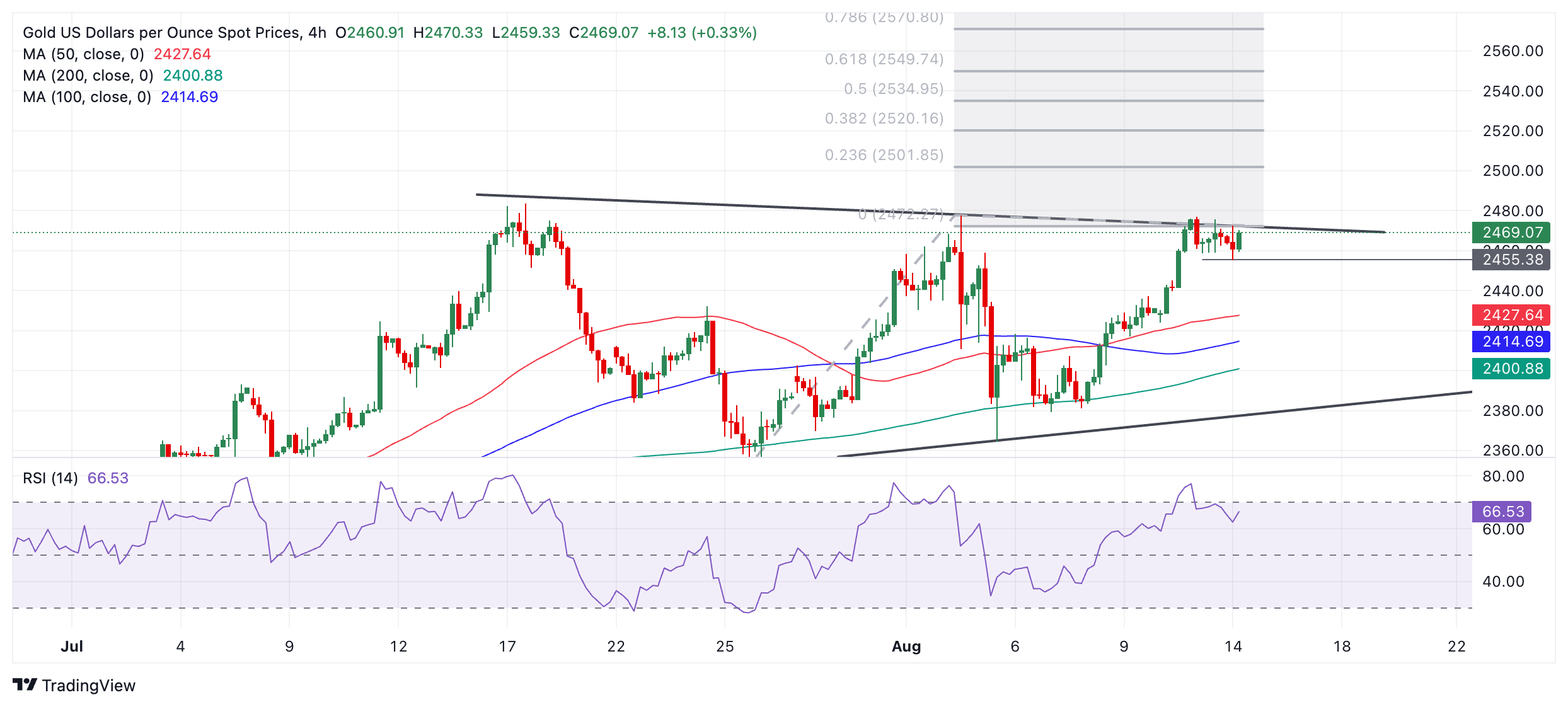- Gold is consolidating under chart resistance as falling US yields and a tense geopolitical backdrop lend support to the metal.
- Upside potential may be limited, however, by overextended positioning.
- The precious metal is at the top of a range-bound consolidation, with the short-term trend leaning toward sideways extension.
Gold (XAU/USD) is trading in the $2,470s on Wednesday as it continues to consolidate after its August rally. Falling US bond yields helped spur the rally as these are negatively correlated with Gold. Safe-haven flows are lending further support to the yellow metal on the back of rising geopolitical concerns emanating from the Middle East and the Russia-Ukraine conflict. However, these safe-haven flows may be capped due to overextended positioning, according to analysts.
Gold boosted by falling PPI
Gold received a boost following the release of US Producer Price Index (PPI) data on Tuesday. The data showed an overall easing in inflationary conditions and raised expectations that interest rates are about to fall in the US. Core PPI, in particular, missed expectations.
Additionally, the Reserve Bank of New Zealand (RBNZ) made a surprise 0.25% cut in its policy rate early on Wednesday, possibly suggesting that interest rates are falling globally. Lower interest rates are positive for gold because they make it more attractive to investors compared to other interest-paying assets.
Gold is “overbought” and offers limited upside potential
Gold may be limited in terms of its upside potential even if geopolitical risk intensifies, according to TD Securities. This view is in line with that of IG Index and Redward Associates, which highlighted extreme positioning in the gold futures market in a recent report.
“Gold as a safe haven is not necessarily a compelling proposition,” says Daniel Ghali, Senior Commodity Strategist at TD Securities.
Although the geopolitical risks of a possible imminent attack by Iran are supporting the yellow metal, the effect is limited because investors are already “overcommitted.” This was reflected in gold’s relatively tepid response to the sell-off triggered by the lack of US Non-Farm Payrolls employment data in early August.
“It’s not just macro funds that are well positioned,” the strategist says, “systematic trend followers are ‘maximally long’, with the threshold for exits continuing to fall by the day. Asian speculators are also vulnerable, with near-record positions in precious metals as a hedge against currency depreciation, the driver of which is now unraveling,” he adds.
Asian central banks had been accumulating gold earlier in the year as the US Dollar (USD) rose following stronger-than-expected US inflation data in the spring, which derailed Federal Reserve (Fed) rate cut expectations. This led to an extreme devaluation of Asian currencies against the USD, and Asian central banks bought gold as a currency hedge.
“This is in stark contrast to the setup earlier in the year, which featured historical underpositioning that ultimately led to strong price performance. As safe-haven flows subside, the positions of several speculative groups may be vulnerable to a reassessment of the Fed’s elevated expectations,” Ghali continues.
Only retail demand from China remains resilient at the moment, according to the strategist, who says flows into Chinese gold ETFs remain strong, however, ETF demand outside of China has “resumed its decline.”
Technical Analysis: Gold continues to consolidate below the range ceiling
Gold is consolidating just below the top of a range it has been bouncing around in since July. The short-term trend is likely sideways and since “the trend is your friend” it is more likely to extend in that direction.
XAU/USD 4-hour chart
A break below $2,455 on a closing basis would help confirm the start of a new bearish leg within the range, thus extending the sideways trend. If so, the price will likely move towards $2,400 or perhaps the range bottom at $2,390. Since the range is narrowing slightly, it could also be a triangle pattern in the final stages of development.
However, a decisive break above the range ceiling would signal the development of a more bullish trend. Such a breakout would likely continue towards at least $2,550, calculated by taking the 0.618 Fibonacci ratio of the range height and extrapolating it upwards.
A decisive breakout would be one characterized by a long green candle that clearly pierces the level and closes near its high, or three green candles in a row that break the level.
Economic indicator
Consumer Price Index (MoM)
The CPI is published on US Labor Department and measures price movements by comparing retail prices of a representative basket of goods and services. The purchasing power of the dollar is diminished by inflation. The CPI is a key indicator for measuring inflation and purchasing trends. A reading above expectations is bullish for the dollar, while a reading below expectations is bearish.
Next post: Wed Aug 14, 2024 12:30 PM
Frequency: Monthly
Dear: 0.2%
Previous: -0.1%
Fountain: US Bureau of Labor Statistics
The US Federal Reserve has a dual mandate of maintaining price stability and maximum employment. According to such mandate, inflation should be at around 2% YoY and has become the weakest pillar of the central bank’s directive ever since the world suffered a pandemic, which extends to these days. Price pressures keep rising amid supply-chain issues and bottlenecks, with the Consumer Price Index (CPI) hanging at multi-decade highs. The Fed has already taken measures to tame inflation and is expected to maintain an aggressive stance in the foreseeable future.
Source: Fx Street
I am Joshua Winder, a senior-level journalist and editor at World Stock Market. I specialize in covering news related to the stock market and economic trends. With more than 8 years of experience in this field, I have become an expert in financial reporting.








